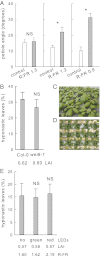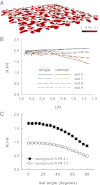Plant neighbor detection through touching leaf tips precedes phytochrome signals
- PMID: 22908260
- PMCID: PMC3437826
- DOI: 10.1073/pnas.1205437109
Plant neighbor detection through touching leaf tips precedes phytochrome signals
Abstract
Plants in dense vegetation compete for resources, including light, and optimize their growth based on neighbor detection cues. The best studied of such behaviors is the shade-avoidance syndrome that positions leaves in optimally lit zones of a vegetation. Although proximate vegetation is known to be sensed through a reduced ratio between red and far-red light, we show here through computational modeling and manipulative experiments that leaves of the rosette species Arabidopsis thaliana first need to move upward to generate sufficient light reflection potential for subsequent occurrence and perception of a reduced red to far-red ratio. This early hyponastic leaf growth response is not induced by known neighbor detection cues under both climate chamber and natural sunlight conditions, and we identify a unique way for plants to detect future competitors through touching of leaf tips. This signal occurs before light signals and appears to be the earliest means of above-ground plant-plant signaling in horizontally growing rosette plants.
Conflict of interest statement
The authors declare no conflict of interest.
Figures




References
-
- Ballaré CL, Sanchez RA, Scopel AL, Ghersa CM. Morphological responses of Datura-ferox L. seedlings to the presence of neighbors. Their relationships with canopy microclimate. Oecologia. 1988;76:288–293. - PubMed
-
- Pierik R, Visser EJW, De Kroon H, Voesenek LACJ. Ethylene is required in tobacco to successfully compete with proximate neighbors. Plant Cell Environ. 2003;26:1229–1234.
-
- Schmitt J, McCormac AC, Smith H. A test of the adaptive plasticity hypothesis using transgenic and mutant plants disabled in phytochrome-mediated elongation responses to neighbors. Am Nat. 1995;146:937–953.
-
- Franklin KA. Shade avoidance. New Phytol. 2008;179:930–944. - PubMed
-
- Vandenbussche F, Pierik R, Millenaar FF, Voesenek LACJ, Van Der Straeten D. Reaching out of the shade. Curr Opin Plant Biol. 2005;8:462–468. - PubMed
Publication types
MeSH terms
Substances
Associated data
- Actions
LinkOut - more resources
Full Text Sources
Molecular Biology Databases

